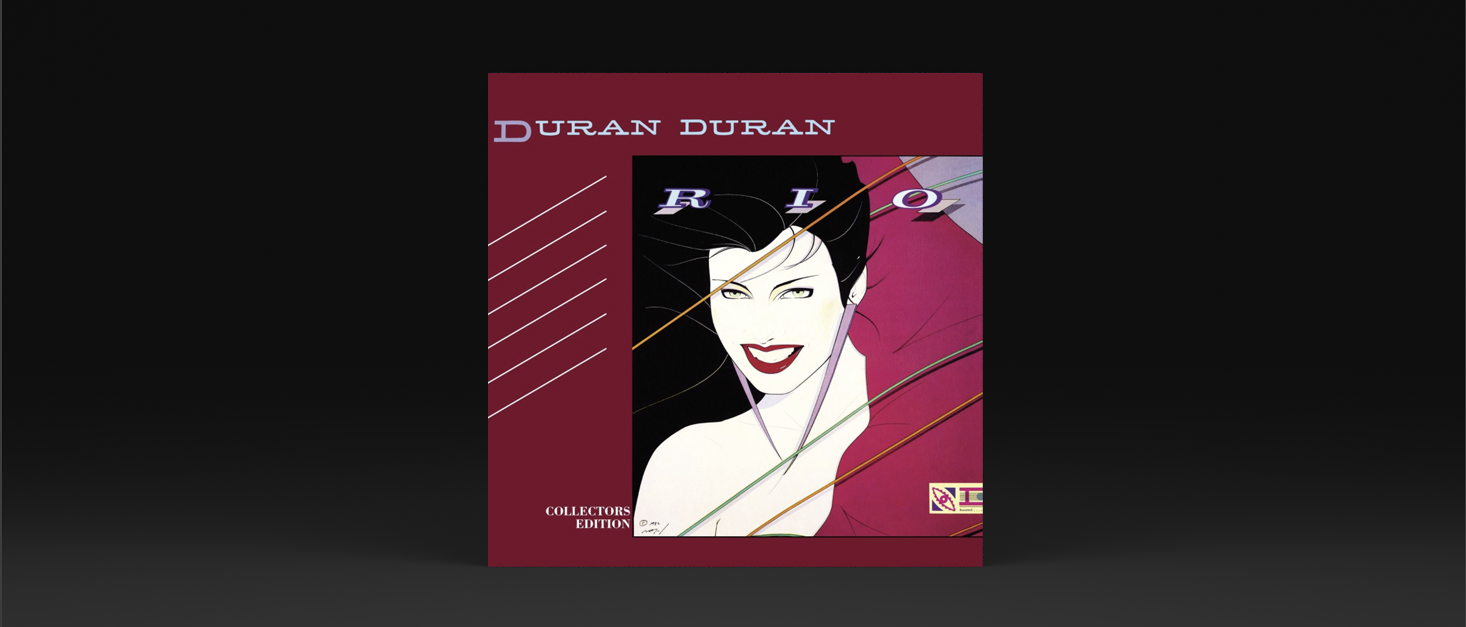
Revisiting Duran Duran's Rio
In the latest in a monthly series reflecting on classic albums from decades past, we explore the energy, artistry and masterful production of Duran Duran’s 1982 studio album, Rio
Tags: Music,"It was a band at the top of its game that was having so much fun, playing every day, and an engineer-producer who just knew exactly what to do and exactly how to channel what he was hearing." So said Duran Duran bass guitarist John Taylor about the group’s second studio album, Rio.
Released on May 10, 1982, Rio arrived at a time when Duran Duran was much-maligned by many serious music fans. The group’s largely teenage following had caused it to be pigeonholed as what we would now call a 'boy band'―yet that’s not how the five members of Duran Duran regarded themselves. "We were really a rock band with synthesisers," drummer Roger Taylor once said, "and we thought we’d be in the studio all the time".
Around the time of the album’s release, Duran Duran embarked upon an American tour. Mindful of how the group’s so-called ‘New Romantic’ image and sound would go down in the southern states of the US, its Stateside promoters suggested Rio should be remixed to give a rawer, more hard rock feel. Yet this bid to refashion their image was stopped in its tracks by the launch of MTV. Duran Duran turned out to have the perfect look for the new US cable television network, which put their music on heavy rotation. The result was vast amounts of records sold, and no change to their sound.
Duran Duran deliberately eschewed musical miserablism to deliver a shiny and sophisticated sound that wasn’t in the least bit self-conscious"
Reflecting on the album’s sound, Roger Taylor later noted: "You can hear all the different influences on Rio― the very funky bass and drums, the dark guitars, quite dark keyboards and optimistic vocals." It was a unique sound at the time, and one that bridged the musical gulf between the brutalism of punk rock and the upbeat, polished 80s pop that Rio popularised. After the doom and gloom of the late 1970s, and the harsh recession of the first couple of years of the following decade, there was definitely a sense that people wanted to have fun. Duran Duran deliberately eschewed musical miserablism to deliver a shiny and sophisticated sound that wasn’t in the least bit self-conscious. Simon Le Bon summed it up pithily at the time, nothing: "Duran Duran is a pop group for young people with a lot of energy."
What is striking now, nearly four decades later, is Rio's musical sophistication, allied to a masterful production by Colin Thurston, who had previously worked with David Bowie and Iggy Pop, and collaborated with Duran Duran on their eponymous debut album 18 months earlier. "[Colin] heard the talent that was in the band and made it modern", said Simon Le Bon. At the time of release, it sounded like nothing else around. The British pop scene had given rise to some very swish productions, from Roxy Music’s Avalon to ABC’s Lexicon of Love via Simple Minds’ New Gold Dream, but Rio’s production was classier still.
Although recording technology was fast advancing by the early 1980s, it was still primitive compared to what we have today. Laid down at EMI’s Manchester Square studios and AIR Studios in January and February 1982, Rio emerged sounding as hot and steamy as its name suggests. This was despite of the lack of MIDI― computer controlled musical instrument connectivity―that was just around the corner. The synthesisers were as analogue as the studio’s open reel tape recorders, and everything had to be committed to tape manually. Roger Taylor remembers: "I’d have to do a single drum take―in those days, you could play the song for five minutes, and make a mistake at the end…and it was, 'Oh no, I've got to do it again!' The tracks were all played live. You couldn't cut it up on the computer and make loops."
The JP8’s string sound was highly distinctive, and has come to be regarded by many musicians as a thing of great auditory beauty
By the early 1980s however, AIR was running a sophisticated multitrack mixing desk which gave Thurston enough room to garnish each song with production details that wouldn’t have been possible just five years earlier. As John Taylor once recalled, "we were coming out of a tradition that was all about guitars and drums", but Rio is dominated by Roland’s Jupiter 8 synthesiser, which had just been released. “I completely fell in love with it”, keyboard player and songwriter Nick Rhodes later explained.
This meant the band’s high energy rock backbone could be gilded with a layer of futuristic sounding electronics. Even at the time of the album’s release, the JP8’s string sound was highly distinctive, and has come to be regarded by many musicians as a thing of great auditory beauty. On this album it was heavily phased, which gives an even more ethereal feel. The synthesiser’s arpeggiator was deployed to great effect; on a good enough system, you can hear it running all the way through tracks such as Hungry Like the Wolf.
The beating heart of Rio’s sound was Roger Taylor’s drums. Taylor used a combination of a standard kit and the (then) new Simmonds electronic drums. "[The electric kit] gave great big fills that sounded like nothing else we'd ever heard," remembered Roger. Even his conventional acoustic drum kit sounded fantastic―a combination of tightly recorded drums with big microphones that gave what he called "a kind of gated ambience". It was a pioneering 80s drum sound, and one that Phil Collins employed on his smash hit In The Air Tonight not long after.
Andy’s chorused, flanged, delayed electric guitar sound brought a sting to tracks like Hungry Like the Wolf, making them harder and grittier. Yet he did contemplative songs brilliantly too
Along with Roger Taylor’s technically brilliant stickwork, John Taylor’s bass guitar playing was hugely important to the sound of Rio. It had a highly syncopated style, with shades of his hero Bernard Edwards from Chic. There’s also a strong whiff of the bass guitar sound on David Bowie’s album, Station To Station. Listen out for John using a plectrum on Hold Back the Rain to give a funkier, more slap-bass type of sound. On other tracks, he’s plucking his bass guitar strings with his fingers, while on Lonely in Your Nightmare he uses a fretless.
This album wouldn’t have been the same without the raunchy guitar work of the third Taylor in the band, Andy. He was much closer in his musical style to drummer Roger than bass player John, pushing an aggressive rock sound that gave the album bite. "His angry guitars gave the band a real edge," said Roger. Andy’s chorused, flanged, delayed electric guitar sound brought a sting to tracks like Hungry Like the Wolf, making them harder and grittier. Yet he did contemplative songs brilliantly too; for the moody Save a Prayer, he used four steel string guitars to give the song extra body and texture. High resolution hi-fi systems show this to great effect, along with the with four overlaid synth lines from Nick Rhodes.
Although the famous Fairlight CMI sampler had been on sale for three years at the time of Rio’s recording, it was still a rare thing in recording studios, and is used sparingly here. Indeed, for the lead-in sound effect to the album’s title track, Thurston resorted to some good old-fashioned trickery. A metal bar was thrown at a piano, and then the tape was reversed and looped. On a serious system, you can hear it’s an analogue tape effect, but many hi-fis wrongly make it sound like a sample. The last song on the album, The Chauffeur, has an effect mid-way through that sounds like breaking glass, but is actually ice being dropped into water. This is taped, but the background voice talking later in the song is a Fairlight sample.
At the time of Rio’s release, much of the music press dismissed the album as escapist nonsense.... Yet looked at now, it's pop/rock tour de force
Last but not least are Simon Le Bon’s distinctive vocals. On many tracks, you can hear his voice overlaid several times over, so that the singer harmonises with himself. "I bought harmonies to the band, from my choirboy training", he once explained. The result is a far more sophisticated sound than you’d expect from what some called 'throwaway pop' at the time. It’s the perfect icing on the cake, and makes for a supremely polished album.
At the time of Rio’s release, much of the music press dismissed the album as escapist nonsense, and candy floss music (The Village Voice sniffily called it “Anglodisco”). Yet looked at now, it is a pop/rock tour de force. Ironically, two of the tracks that were never released as singles―Lonely in your Nightmare and Last Chance on the Stairway―are arguably its strongest songs.
"The writing is fantastic … every one of us is performing … at the absolute peak of our talents", John Taylor later concluded in his memoirs. Early 80s pop music fans agreed unreservedly, buying it in droves and eventually giving it double platinum status. Rio topped the album charts in the UK, Australia and Canada and spent 129 weeks in the US Billboard 200.
"Rio is a bright colourful outburst", Nick Rhodes once said. "We wanted to put some brightness into other people's lives―that's one of the things that changed in the 80s, it suddenly became very optimistic. We just thought 'this what you do―you just put the blinkers on and go'… Sometimes you can overthink things and miss it by a mile, other times if you just do what comes naturally you hit that nerve."














